Bobcat (Lynx rufus)
Ontario, Canada
Appearance
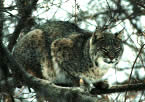 Overall
colouration, reddish to tawny brown to grey on its back, dotted
with numerous blackish spots along the midline of the back. Underside,
whitish with dark spots. The long guard hairs on its coat are black
tipped. Short tail, blackish above and white below. Legs, tawny
with blackish horizontal streaks. Prominent streaked ruff on cheeks
extending below the jaw. Ears, short with dark ear tufts. It has
large yellow eyes. The retractable claws on its front feet are about
4.5 cm long.
Overall
colouration, reddish to tawny brown to grey on its back, dotted
with numerous blackish spots along the midline of the back. Underside,
whitish with dark spots. The long guard hairs on its coat are black
tipped. Short tail, blackish above and white below. Legs, tawny
with blackish horizontal streaks. Prominent streaked ruff on cheeks
extending below the jaw. Ears, short with dark ear tufts. It has
large yellow eyes. The retractable claws on its front feet are about
4.5 cm long.
Can be mistaken for a lynx but the bob cat has shorther legs and smaller feet.
The male bobcat's body is about 80 to 100 cm long, including a short tail of about 12 to 15 cm. The average weight for the male is about 10 kg and for the female is slightly less. An average domestic cat weighs about three and one half kg. This means the average male bobcat weighs more than twice as much as the average house cat. There are records of some bobcats weighing over 25 kg. In his book, titled Leonard Rue reports that in Colorado a bobcat weighing 31 kg was killed.
Habitat/Behavior
Primarily in the southern areas of Northwestern Ontario. Prefers hardwood forests, brushy scrubland, rocky mountainous areas and sometimes the wooded outskirts of inhabited areas.
The bob cat's short legs and smaller feet make it less adapted to deep winter snow than the lynx, restricting its range to the southern boreal forest. It is a solitary hunter, congregating only during breeding season when a number of males may compete for one female.
The males travel in a circular way through their home range in search of food. They have resting sites along the way and may take seven to ten days to complete the route.
While domestic cats (house cats) try to avoid water, the bobcats enjoy it. They have been spotted playing and swimming in water. The bobcat makes sounds similar to a domestic cat. They meow, purr, hiss, and snarl.
Food
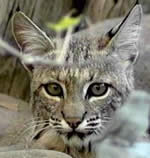 The
bobcat is usually found anywhere where there is an abundant supply
of snowshoe hares, the main element of its diet. It will also feed
on smaller rodents, ruffed grouse, reptiles and insects. On occasion
it will attack a smaller or injured white-tailed deer.
The
bobcat is usually found anywhere where there is an abundant supply
of snowshoe hares, the main element of its diet. It will also feed
on smaller rodents, ruffed grouse, reptiles and insects. On occasion
it will attack a smaller or injured white-tailed deer.
The bobcat's favourite food is rabbit, which may make up 90 percent of the bobcat's diet. The bobcat also hunts and eats small prey like mice, ground squirrels, chipmunks, and muskrats. In winter, the bobcat hunts deer who are weak. It jumps onto the deer's back and bites its neck just below the skull. The bobcat doesn't chew its food. It uses its sharp teeth to cut small pieces of meat and swallows them whole.
Range/Territory
Bobcats live in southern Ontario, but it is difficult to tell how many live in the province.
The male and female bobcats occupy home ranges or territories. The male bobcats have much larger home ranges than the females. An area about 150 sq km is common for the male. The home range for the female may be only 15 sq km.
Breeding Biology
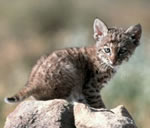 Bobcats
are solitary for most of the year, but the male and female get together
to mate in February or March. A gestation period of about 50 to
60 days is needed and then the female gives birth to litters that
average three kittens. The kittens weigh about 200 grams and are
20 cm long. Their eyes are closed at birth and open in about ten
days. The kittens' eyes are blue at birth but gradually change to
yellow.
Bobcats
are solitary for most of the year, but the male and female get together
to mate in February or March. A gestation period of about 50 to
60 days is needed and then the female gives birth to litters that
average three kittens. The kittens weigh about 200 grams and are
20 cm long. Their eyes are closed at birth and open in about ten
days. The kittens' eyes are blue at birth but gradually change to
yellow.
Track
Hind print registers on the larger fore print while walking and while trotting two prints are observed the hind leading the fore. At faster speeds a group of four prints in a lope pattern can be seen. In deep snow bobcats feet leave draglines.
Prints:
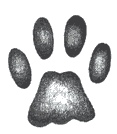 |
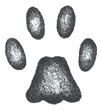 |
 |
 |
 |
Fore |
Hind |
Walking |
Trotting |
Loping |
Fore Prints (Hind print slightly smaller)
Length: 1.8 - 2.5 in (4.6 - 6.4 cm)
Width: 1.8 - 2.6 in (4.6 - 6.6cm)
Straddle
4.0 - 7.0 in (10 - 18 cm)
Stride
Walking: 18.0 - 16 in (20 - 41 cm)
Running: 4.0 - 8.0 ft (1.2 - 2.4 cm)
Size (Female slightly smaller)
Height: 20 - 22 in (51 - 56 cm)
Length: 25 - 30 in(64 - 76 cm)
Weight
Males: 15 - 35 lbs (6.8 - 16 kg)
